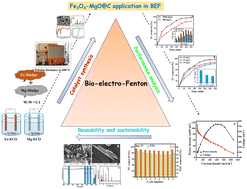Developing efficient Fenton catalysts for the remediation of emerging pollutants is one of the challenges for researchers. Herein, a novel cathode catalyst via the utilization of waste electro-coagulated (ECO) sludge was synthesized for the efficient abatement of tetracycline (TC) through the bio-electro-Fenton (BEF) process. The carbon-felt-coated heterogeneous catalyst (Fe3O4–MgO@C) resulted in more than 96.7 ± 2.2% removal of 10 mg L−1 of TC during 420 min of operating time following pseudo-first-order kinetics at neutral pH. Moreover, 53.5 ± 2.5% mineralization in terms of total organic carbon removal was obtained for real municipal wastewater during the BEF treatment. Radical experimentation displayed ˙OH as the dominant oxidative species for TC degradation. Besides, the maximum power density achieved by Fe3O4–MgO@C-BEF was 114.5 ± 4.5 mW m−2, which was 2.6-times more than BEF operated without any catalyst (44.2 ± 2.7 mW m−2). The co-precipitation in the cathodic chamber of BEF via external addition of Fe3O4–MgO@C (63.6 mg L−1) resulted in 1.20 ± 0.08 g L−1 of struvite recovery from synthetic urine. Overall, the sludge-derived catalyst might be beneficial for reducing the economics of future full-scale implementation of the technology, contributing to a circular economy, and fixing the lacunas of ECO technology for sludge management, thereby proposing an effective waste management strategy.
